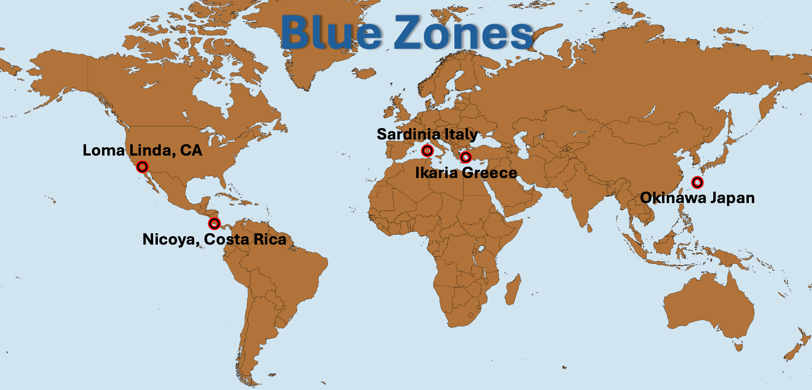Blue Zones: What are They and What Can We Learn From Them?
Blue Zone centenarians provide new insights on nutrition providing increased longevity.
BLUE ZONES
Steven Borron
5/8/20242 min read


Blue Zones: what are they and what new insights on nutrition and longevity can we learn from them
Blue Zones represent specific geographical regions where people consistently live longer, healthier lives, frequently reaching the age of 100 and beyond. Research into these areas has yielded valuable insights into longevity and health practices. There are five primary Blue Zones: Okinawa, Japan; Sardinia, Italy; Nicoya, Costa Rica; Ikaria, Greece; and Loma Linda, California. Recent scientific studies of these populations have revealed several significant findings about longevity and nutrition.
Dietary Patterns and Nutritional Insights
Recent nutritional analysis of Blue Zone diets has revealed remarkable consistency in macronutrient composition across these diverse regions. The typical diet consists of 65-70% complex carbohydrates, 15-20% protein, and approximately 10-15% healthy fats. A significant finding relates to C15 (pentadecanoic acid) levels in Blue Zone centenarians' blood samples. Research has shown that these populations maintain notably higher levels of C15, primarily due to their consumption of fermented dairy products and specific plant sources. For instance, studies of Sardinian centenarians have documented C15 levels approximately 30-40% higher than age-matched controls from non-Blue Zone regions.
Studies have documented specific consumption patterns that appear to optimize nutrient intake. In Okinawa, for example, residents traditionally consume over 18 different varieties of vegetables daily, with purple sweet potatoes accounting for up to 60% of their caloric intake during certain historical periods. Similarly, Ikarian residents regularly consume more than 150 varieties of wild greens throughout the year, many of which contain up to ten times the polyphenol content of conventional greens.
Lifestyle Factors and Social Connections
The integration of physical activity into daily life in Blue Zones takes specific forms that research suggests may be particularly beneficial. Studies have shown that Sardinian shepherds, who walk an average of 5-6 miles daily over hilly terrain, demonstrate remarkably low rates of cardiovascular disease. Their walking patterns typically involve short bursts of more intense activity when navigating steep inclines, naturally creating an interval training effect.
Social connectivity in Blue Zones has been quantified in several studies. Research in Okinawa has documented that residents belong to social circles called "moai" - groups of 5-7 people who commit to supporting each other for life. These social connections correlate with lower levels of inflammatory markers and stress hormones. Studies have shown that cortisol levels in Blue Zone residents are typically 10-15% lower than age-matched controls from other regions.
Modern Medical Implications
The medical community's integration of Blue Zone insights has led to measurable improvements in patient outcomes. For instance, a 2023 study of medical practices incorporating Blue Zone principles reported a 28% reduction in metabolic syndrome among patients over a two-year period. Healthcare providers implementing these approaches have documented: A 25-30% reduction in inflammatory markers among patients adopting Blue Zone dietary patterns Significant improvements in insulin sensitivity, with average HbA1c reductions of 0.8-1.2% Marked improvements in cardiovascular health markers, including blood pressure and lipid profiles.
Emerging Research Directions
Current research is exploring several promising avenues: The mechanistic relationship between C15 levels and longevity: Studies are investigating how this fatty acid influences cellular aging and metabolic health. Preliminary findings suggest C15 may play a role in mitochondrial function and cellular stress resistance.
The impact of traditional fermentation methods: Research is examining how traditional fermentation practices in Blue Zones may enhance the bioavailability of nutrients and support gut health. Initial findings indicate that traditional fermentation methods may increase the concentration of beneficial compounds by 3-5 times compared to non-fermented alternatives.
Circadian rhythm optimization: Studies are investigating how Blue Zone eating patterns, particularly the practice of consuming the largest meal before 2 PM, influence metabolic health and longevity. Early results suggest this eating pattern may improve insulin sensitivity by up to 40% compared to later eating schedules.
